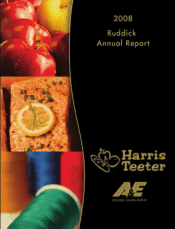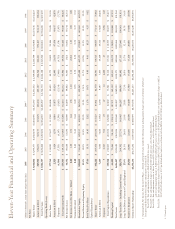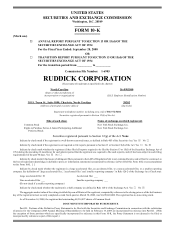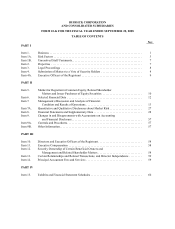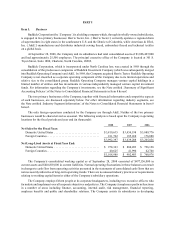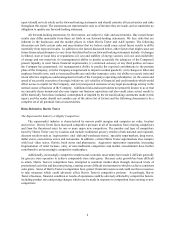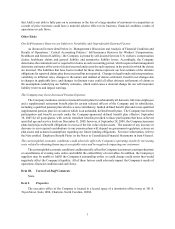Harris Teeter 2008 Annual Report Download - page 10
Download and view the complete annual report
Please find page 10 of the 2008 Harris Teeter annual report below. You can navigate through the pages in the report by either clicking on the pages listed below, or by using the keyword search tool below to find specific information within the annual report.6
property or to borrow using real property as collateral. Liabilities or costs resulting from noncompliance with
current or future applicable environmental laws or other claims relating to environmental matters could have a
material adverse effect on Harris Teeter’s business, financial condition or results of operations.
Risks Related to A&E
A&E Operates in a Competitive Global Industry
A&E competes on a global basis with a large number of manufacturers in the highly competitive sewing
thread, embroidery thread and technical textile industries. Maintaining A&E’s competitive position may require
substantial investments in product development efforts, manufacturing facilities, distribution network and sales
and marketing activities. Competitive pressures may also result in decreased demand for A&E’s products or
force A&E to lower its prices. Other generally adverse economic and industry conditions, including a decline in
consumer demand for apparel products, could have a material adverse effect on A&E’s business.
A&E may not Succeed at Integrating Its Acquisitions
In recent years, A&E has expanded its foreign production and distribution capacity by acquiring other
manufacturers, entering into joint ventures or starting new businesses. Management expects A&E to continue
this activity and expand foreign production and distribution operations through acquisitions, joint ventures or
new start-up operations. The process of combining these acquisitions with A&E’s existing businesses involves
risks. A&E will face challenges in consolidating functions, integrating organizations, procedures, operations
and product lines in a timely and efficient manner and retaining key personnel. Failure to successfully
manage and integrate acquisitions, joint ventures or new start-up businesses could lead to the potential loss
of customers, the potential loss of employees who may be vital to the new operations, the potential loss of
business opportunities or other adverse consequences that could affect A&E’s financial condition and results of
operations. Even if integration occurs successfully, failure of future acquisitions to achieve levels of anticipated
sales growth, profitability or productivity may adversely impact A&E’s financial condition and results of
operations. Additionally, expansions involving foreign markets may present other complexities that may require
additional attention from members of management. The diversion of management attention and any difficulties
encountered in the transition and integration process could have a material adverse effect on A&E’s revenues,
level of expenses and operating results.
A&E Has Substantial International Operations
In fiscal 2008, approximately 55% of A&E’s net sales and a large portion of A&E’s production occurred
outside the United States, primarily in Europe, Latin America and Asia. A&E’s corporate strategy includes
the expansion and growth of its international business on a worldwide basis. As a result, A&E’s operations are
subject to various political, economic and other uncertainties, including risks of restrictive taxation policies,
changing political conditions and governmental regulations. A&E’s foreign operations also subjects A&E to the
risks inherent in currency translations. A&E’s global operations make it impossible to eliminate completely all
foreign currency translation risks and its impact on A&E’s financial results.
A&E Has Raw Material Price Volatility
The significant price volatility of many of A&E’s raw materials may result in increased production costs,
which A&E may not be able to pass on to its customers. A significant portion of the raw materials A&E uses
in manufacturing thread and technical textiles are petroleum-based. The prices for petroleum and petroleum-
related products are volatile. While A&E at times in the past has been able to increase product prices due to
raw material increases, A&E generally is not able to immediately raise product prices and may be unable to
completely pass on underlying cost increases to its customers. Additional raw material and energy cost increases

